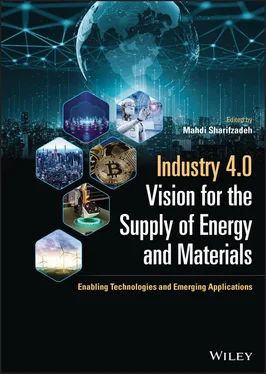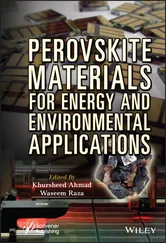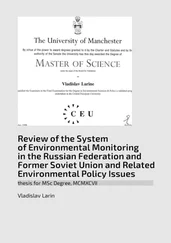Industry 4.0 Vision for the Supply of Energy and Materials
Здесь есть возможность читать онлайн «Industry 4.0 Vision for the Supply of Energy and Materials» — ознакомительный отрывок электронной книги совершенно бесплатно, а после прочтения отрывка купить полную версию. В некоторых случаях можно слушать аудио, скачать через торрент в формате fb2 и присутствует краткое содержание. Жанр: unrecognised, на английском языке. Описание произведения, (предисловие) а так же отзывы посетителей доступны на портале библиотеки ЛибКат.
- Название:Industry 4.0 Vision for the Supply of Energy and Materials
- Автор:
- Жанр:
- Год:неизвестен
- ISBN:нет данных
- Рейтинг книги:4 / 5. Голосов: 1
-
Избранное:Добавить в избранное
- Отзывы:
-
Ваша оценка:
- 80
- 1
- 2
- 3
- 4
- 5
Industry 4.0 Vision for the Supply of Energy and Materials: краткое содержание, описание и аннотация
Предлагаем к чтению аннотацию, описание, краткое содержание или предисловие (зависит от того, что написал сам автор книги «Industry 4.0 Vision for the Supply of Energy and Materials»). Если вы не нашли необходимую информацию о книге — напишите в комментариях, мы постараемся отыскать её.
Explore the impact of Industry 4.0 technologies on the supply chain with this authoritative text written by a leader in his field Industry 4.0 Vision for the Supply of Energy and Materials,
Industry 4.0 Vision for the Supply of Energy and Materials
Industry 4.0 Vision for the Supply of Energy and Materials — читать онлайн ознакомительный отрывок
Ниже представлен текст книги, разбитый по страницам. Система сохранения места последней прочитанной страницы, позволяет с удобством читать онлайн бесплатно книгу «Industry 4.0 Vision for the Supply of Energy and Materials», без необходимости каждый раз заново искать на чём Вы остановились. Поставьте закладку, и сможете в любой момент перейти на страницу, на которой закончили чтение.
Интервал:
Закладка:
Physical devices in WIA-PA networks are categorized into five classes [76]: (1) handheld devices to monitor and control the production plants and configure network devices; (2) field devices (sensors and actuators) located in the field to control or monitor industrial processes; (3) routing devices; (4) gateway devices that connect WIA-PA networks to various plant networks; and (5) a host computer as the user interface for management and maintenance. Both centralized and distributed mechanisms are deployed in WIA-PA networks to perform network and security management. Typically, network manager configures the network, schedules communication, handles routing tables, and protects the overall network, whereas the security manager is responsible for security and authentication management in the network. To conserve energy in WIA-PA networks, two-level aggregation mechanism is exploited: packet aggregation at network and application layers. This is different from WirelessHART and ISA100.11a, which utilizes only a one-level packet aggregation scheme. Additionally, WIA-PA adopts two-stage communication resource allocation.
1.4.1.2 IEEE 802.15.1 Standard
It was approved in 2002 and designed for short-range, low-power, and low-cost connectivity in WPAN applications. IEEE 802.15.1 is established on Bluetooth v1.1 foundation specifications that govern Bluetooth technology [79]. There are two main variations of this technology: classic Bluetooth and Bluetooth low energy (BLE). Classic Bluetooth supports devices with high demand of small transmission and low energy consumption, whereas BLE is ideal for applications that require communication of small quantities of data on an occasional or periodic basis.
Bluetooth classic.The Bluetooth PHY layer is adapted from the IEEE 802.15.1 standard and operates in the frequency band of 2.4 GHz. Its transmission technique exploits frequency hopping spread spectrum (FHSS). This results in the reduction of interference from nearby systems sharing the same frequency band (ISM band) and increases system robustness. Bluetooth defines two types of network topologies, namely, piconet and scatternet. Piconet is a single-hop topology that enables communication between one master node and multiple slave nodes. A scatternet topology is a cluster of Bluetooth piconets overlapping in space and time; there is only one master node, while a slave node could operate as slave in different piconets. Bluetooth MAC layer mainly focuses on establishing physical connections between the master and slaves, synchronizing network nodes with the master node’s clock, packet transmission on physical channels, and device management for energy-saving modes [80].
Bluetooth low energy (BLE).A smart variation of the IEEE 802.15.1 standard, also known as Smart Bluetooth, BLE supports industrial wireless communication [81]. It is designed for short-range communication and, compared with classic Bluetooth, has much smaller latency, lower energy consumption, and increased range with higher data rates [49]. BLE adopts master–slave architecture, and role of a device (as master or slave) is defined in its MAC layer. To decrease channel sensitivity to interference and multipath fading, BLE employs TDMA-based MAC protocol and frequency hopping [82]. Additionally, the center frequency of channels has been assigned in a way to minimize interference with IEEE 802.11 channels [57]. Even though there are options to increase BLE’s data rate at the expense of range, the limited range of BLE makes it inept for extensive IIoT deployments. To address this problem, a Bluetooth mesh network is introduced to increase the number of relaying neighbors, making it applicable to industrial use cases such as alerting and logging systems [83]. Recently most wearables are equipped with BLE interfaces. Overall, considering its low power consumption, BLE could be utilized as a practical and effective wireless technology for IoT applications that require short-range communication [68, 81].
1.4.1.3 IEEE 802.11 Standard (Wi-Fi)
Wi-Fi is a family of wireless network protocols regulated by the IEEE 802.11 standard [84], originally designed to offer high data rate connectivity and Internet access to a limited number of devices for WLAN. The early versions of the standard (IEEE 802.11b/g/n/ac) are limited by high power consumption and frame overhead. In addition, they do not fully support small and deterministic payloads required for mission-critical IoT applications. Thus, a set of modifications is proposed by IEEE 802.11 working group to amend WLAN to IoT scenarios. The first of such efforts was IEEE 802.11ah, known as Wi-Fi HaLow, which fulfills IoT requirements and could achieve denser deployment, lower overhead, and less energy consumption compared with legacy Wi-Fi networks [85]. The main features of the IEEE 802.11ah PHY layer are inherited from IEEE 802.11ac, which accommodates relatively narrow channel bandwidths. Its MAC layer has adopted some enhancements to improve power-saving features, to assist large number of devices, and to increase data rate. IEEE802.11ah supports machine-to-machine (M2M) communications for IoT services such as smart metering and industrial automation [86].
The IEEE 802.11ax standard, also called Wi-Fi6, is another effort that supports mission-critical data transmissions [87]. It underpins complex applications such as VR and robotic motion control [88]. To ensure distinct transmission scheduling for time-critical and delay-sensitive use cases, the MAC layer of Wi-Fi6 adopts orthogonal frequency division multiple access (OFDMA). Moreover, adaptive modulation and coding schemes are used in MAC protocol to tackle high levels of variations in wireless links [89].
1.4.2 Long-Range Wireless Communication
Long-range wireless networks are adapted for scenarios that require long-distance data transmission (up to 100 km). These wireless communications include very small aperture terminal (VSAT) technology, cellular networks (2G/3G/4G, LTE, and 5G), and low power wide area networks (LPWANs). Since VSAT
technology is based on satellite communication and employed in hard-to-reach places or remote sites, it is beyond the scope of this chapter. Since we will review cellular networks in Section 1.5, in this section we will focus on a number of main LPWAN technologies: long range (LoRa) [90], LTE-M [91], and narrowband Internet of things (NB-IoT) [92].
1.4.2.1 Low Power Wide Area Network (LPWAN)
The term LPWAN, also known as low power wide area (LPWA) network or low power network (LPN), was primarily designed for M2M networking. LPWAN denotes energy-efficient, low-cost, and especially wide area coverage communication [93]. “Wide area” in LPWAN relates to radio links of over 1 kilometer range. The applications of LPWAN are limited to low bandwidth communication with low data rate and infrequent transmissions [94]. Therefore, it is well-suited for IoT services that require small data transmission over a wide area. For industrial IoT systems, LRWAN is suitable for retrieving data from field devices that transmit low traffic (a few bytes in the payload) over long distances for a short period of air time for each node per day.
Wireless LPWANs have emerged in licensed and unlicensed frequencies. They include open standards and proprietary options such as Huawei’s cellular IoT (CIoT) [95] and NWave [96] and differ in coverage area and other technical characteristics. A set of LPWAN standards has been specified by GSMA wireless industry association in 2015 to assist network operators to meet the requirements of IoT use cases in terms of coverage, energy consumption, and cost [97]. Consequently, LPWAN became a preferable choice for IoT use cases and gained significant attention as a complementary technology to the existing cellular networks. LPWAN comes in various ranges, sizes, and operational properties. In this section, we overview three LPWAN technologies with different features.
Читать дальшеИнтервал:
Закладка:
Похожие книги на «Industry 4.0 Vision for the Supply of Energy and Materials»
Представляем Вашему вниманию похожие книги на «Industry 4.0 Vision for the Supply of Energy and Materials» списком для выбора. Мы отобрали схожую по названию и смыслу литературу в надежде предоставить читателям больше вариантов отыскать новые, интересные, ещё непрочитанные произведения.
Обсуждение, отзывы о книге «Industry 4.0 Vision for the Supply of Energy and Materials» и просто собственные мнения читателей. Оставьте ваши комментарии, напишите, что Вы думаете о произведении, его смысле или главных героях. Укажите что конкретно понравилось, а что нет, и почему Вы так считаете.












